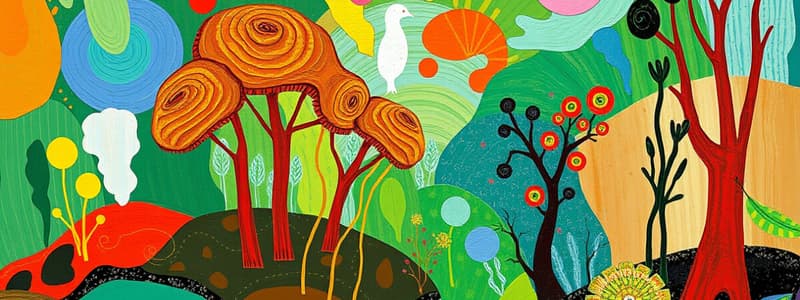Podcast
Questions and Answers
What is a biome?
What is a biome?
A biome is an area of the planet that can be classified according to the plants and animals that live in it.
What factors determine what life exists in a biome?
What factors determine what life exists in a biome?
Temperature, soil, and the amount of light and water help determine what life exists in a biome.
What is an ecosystem?
What is an ecosystem?
An ecosystem is the interaction of living and nonliving things in an environment.
What is the difference between a biome and an ecosystem?
What is the difference between a biome and an ecosystem?
How are biomes classified?
How are biomes classified?
Where are the boundary lines between biomes?
Where are the boundary lines between biomes?
How are biomes affected by climate change?
How are biomes affected by climate change?
What factors affect biomes?
What factors affect biomes?
How are biomes characterized?
How are biomes characterized?
What can you tell me about desert biomes?
What can you tell me about desert biomes?
What can you tell me about forest biomes?
What can you tell me about forest biomes?
What can you tell me about freshwater biomes?
What can you tell me about freshwater biomes?
What can you tell me about grassland biomes?
What can you tell me about grassland biomes?
What can you tell me about marine biomes?
What can you tell me about marine biomes?
What can you tell me about tundra biomes?
What can you tell me about tundra biomes?
Flashcards are hidden until you start studying
Study Notes
Biomes Overview
- A biome is a large area classified by its distinct plant and animal communities.
- Major determining factors for a biome include temperature, soil, light, and water availability.
Ecosystems vs Biomes
- An ecosystem involves interactions between living and nonliving elements in a specific environment.
- A biome comprises multiple ecosystems; for example, an aquatic biome includes coral reefs and kelp forests.
Classification of Biomes
- Classification varies among scientists; some recognize six major biomes:
- Forest
- Grassland
- Freshwater
- Marine
- Desert
- Tundra
- More detailed classifications can identify numerous biomes based on specific characteristics.
Boundary Definitions
- Biome boundaries are often indistinct, with transition zones like grasslands between forests and coasts between aquatic and terrestrial biomes.
Climate Change Impact
- Climate change causes biomes to shift; historical lush areas in North Africa transformed into the Sahara Desert.
Factors Influencing Biomes
- Key influences on biomes include:
- Length of daylight and darkness
- Growing season length
- Soil types
- Precipitation variations and intensity
Characteristics of Biomes
- Communities consist of interdependent plants and animals.
- Adaptations are traits evolved for survival in specific environments.
- Multiple ecosystems contribute to the overall structure of a biome.
Desert Biomes
- Characterized as the driest biome; receives around 50cm of rainfall annually.
- Organisms must adapt to extreme temperature changes and scarce water supply.
- Types include hot and dry, semiarid, coastal, and cold deserts.
Forest Biomes
- Forests occupy approximately one-third of the Earth's land surface.
- Dominated by trees, they play a crucial role in carbon absorption and oxygen production.
- Types include tropical, deciduous, and taiga (boreal) forests.
Freshwater Biomes
- Freshwater is defined as having less than 1% salt content, crucial for various species.
- Essential for drinking water and supporting plant life.
- Includes ponds, lakes, streams, rivers, and wetlands.
Grassland Biomes
- Grass length and tree density depend on rainfall, which is greater than deserts but less than rainforests.
- Trees primarily grow near water sources.
- Types include savannas and temperate grasslands.
Marine Biomes
- Cover about 70% of the Earth's surface and include deep areas capable of housing mountains and volcanoes.
- Provide most of the planet's rainfall and support diverse marine life.
- Categories include oceans, coral reefs, and estuaries.
Tundra Biomes
- The coldest biome, featuring limited species diversity.
- Named from the Finnish word "tunturi," meaning treeless plain.
- Receives less rainfall than deserts but remains waterlogged due to slow evaporation; supports hardy plants like mosses and lichens with short growing seasons.
Studying That Suits You
Use AI to generate personalized quizzes and flashcards to suit your learning preferences.




